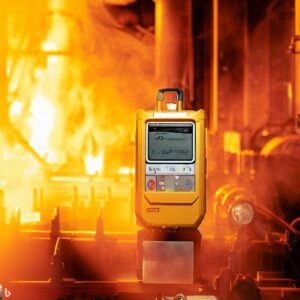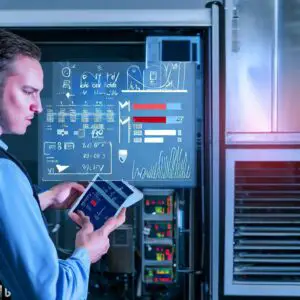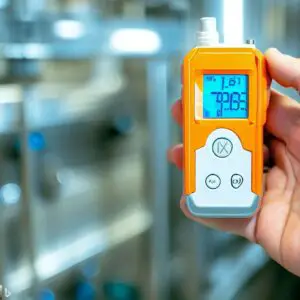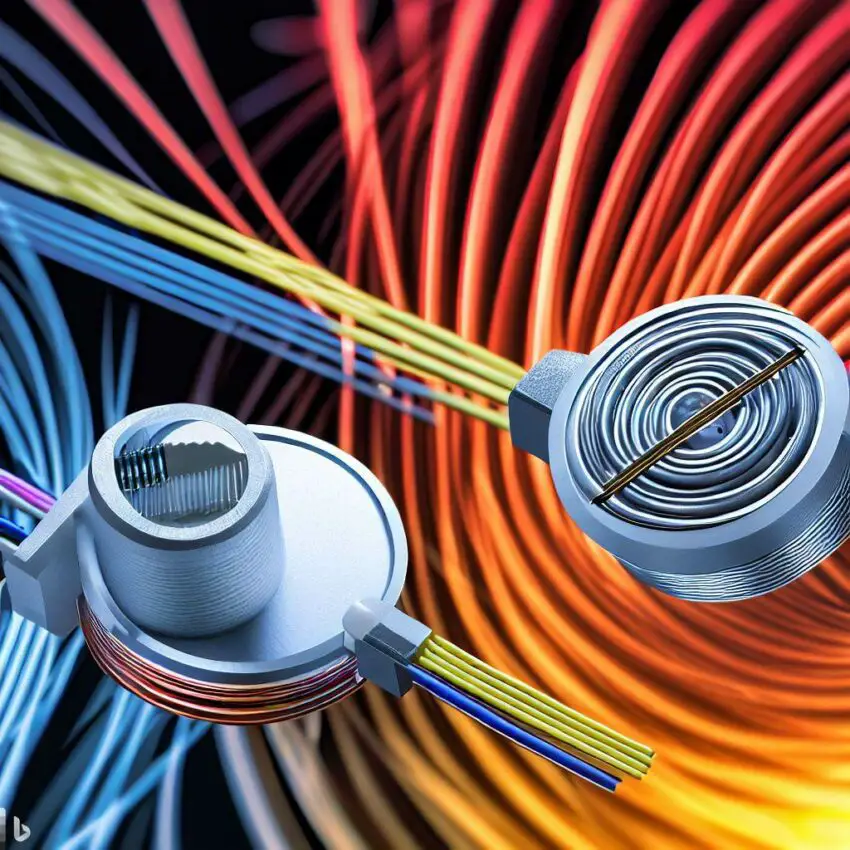When it comes to measuring temperature, there are two main types of sensors: RTD (resistance temperature detectors) and thermocouples. Both have their own advantages and disadvantages, making them suitable for different applications.
RTDs are sensors that measure temperature by detecting changes in electrical resistance. They are widely used in industrial applications where high accuracy is required, such as pharmaceuticals or food processing.
On the other hand, thermocouples work by measuring the voltage generated when two dissimilar metals are joined together at one end and exposed to a temperature gradient at the other end. They are commonly used in situations where fast response time is needed or in harsh environments where other sensors would not be able to function properly.
By examining the pros and cons of each type of sensor, we can determine which one is best suited for a particular application.
Understanding Rtds: How They Work And Their Advantages
RTDs, or resistance temperature detectors, are sensors used to measure temperature changes. They consist of a thin wire made of platinum, copper or nickel and are constructed by winding the wire around a ceramic or glass core.
The wire is then connected to an electrical circuit which measures the change in resistance as temperature changes occur.
The calibration of an RTD involves measuring its resistance at two known temperatures and calculating the resistance at other temperatures using a mathematical formula. This enables accurate temperature readings to be taken and provides greater accuracy than other temperature sensors such as thermocouples.
One of the advantages of using an RTD over a thermocouple is that they provide higher accuracy measurements. This is because RTDs have a linear relationship between resistance and temperature, whereas thermocouples do not.
Additionally, RTDs offer better stability over time due to their construction materials being less prone to corrosion.
Another advantage of using an RTD is that they can be used for a wider range of temperatures compared to thermocouples. While thermocouples can operate at higher temperatures, they are more susceptible to errors due to drift and age-related degradation. In contrast, RTDs can provide accurate measurements from -200°C up to 850°C without significant loss of accuracy over time.
The Basics Of Thermocouples: How They Measure Temperature
 Thermocouples consist of two different types of metal alloys.
Thermocouples consist of two different types of metal alloys.
Depending on the type, they can measure temperatures ranging from -200°C to 1000°C.
RTDs are more accurate than thermocouples, but they have a much narrower temperature range of -200°C to 850°C.
Both types of temperature sensors provide reliable and cost-effective solutions for measuring temperature.
Thermocouple Types
Are you looking for a temperature measuring device that can withstand harsh environments? One option is to use thermocouples. They are widely used in various industries due to their durability and ability to measure high temperatures.
However, not all thermocouples are created equal. There are different types of thermocouples, each with its own characteristics and applications.
One of the most common types of thermocouples is the Type K thermocouple. It is made up of a chromel wire (positive leg) and an alumel wire (negative leg) connected at the thermocouple junctions. This type of thermocouple has a wide temperature range (-200°C to 1260°C) and good accuracy (+/- 1.5°C).
Another popular type is the RTD or resistance temperature detector, which measures temperature by sensing changes in electrical resistance. Unlike thermocouples, RTDs have low drift and better accuracy (+/- 0.1°C), but they have a lower temperature range (-200°C to 850°C).
When choosing between an RTD and a thermocouple, it’s essential to consider factors such as accuracy, temperature range, and cost. Additionally, it’s important to note that thermocouples require cold junction compensation due to the fact that they rely on voltage differences between two dissimilar metals at their junctions.
Cold junction compensation involves measuring the temperature at the connection point between the thermocouple wires and compensating for any changes in ambient temperature.
In conclusion, selecting the right type of thermometer for your application requires careful consideration of several factors such as cost, reliability, and accuracy requirements. While both RTDs and thermocouples offer unique benefits depending on your needs, it’s important to understand their differences before making a choice. Whether using an RTD or a thermocouple, ensure proper installation methods are employed for optimal performance when measuring temperatures in harsh environments.
Temperature Range
So far, we have discussed the basics of thermocouples and their different types. However, there is another important factor to consider when choosing between RTDs and thermocouples – temperature range.
While both devices are capable of measuring extremes in temperature, they differ in their maximum and minimum limits. Thermocouples can measure temperatures as low as -200°C and as high as 2700°C, depending on the type of thermocouple used. On the other hand, RTDs have a lower temperature range with a maximum limit of around 850°C.
It’s also important to note that both RTDs and thermocouples require calibration methods to ensure accurate temperature readings. For RTDs, this involves comparing the device’s output to a known reference source at two or more points along its operating range. In contrast, thermocouples require special calibration equipment due to their non-linear response to temperature changes.
When selecting which device to use for your application, it’s crucial to consider your specific temperature requirements in order to make an informed decision. In addition, proper installation methods should be employed for optimal performance when measuring temperatures in extreme environments.
In summary, while both RTDs and thermocouples offer unique benefits for measuring temperature in harsh environments, they differ in their temperature ranges and calibration methods. It’s important to choose the appropriate device based on your specific needs and ensure proper installation procedures are followed for accurate measurements.
Accuracy And Precision: Comparing Rtds And Thermocouples
Now that we have a clear understanding of how thermocouples work, let’s compare them to RTDs in terms of accuracy and precision. Both are popular temperature sensors used in various industries, but they differ in their measurement range and cost.
RTDs provide higher accuracy and stability than thermocouples over a narrow temperature range (-200°C to 850°C). They are ideal for applications where precise temperature measurements are required, such as laboratory equipment or pharmaceutical manufacturing.
On the other hand, thermocouples can measure temperatures across a wide range (-270°C to 1820°C) and are commonly used in high-temperature applications like furnaces or gas turbines.
When it comes to cost, thermocouples are generally less expensive than RTDs. Their simple construction and lower material costs make them an attractive option for many industries. However, it’s essential to consider the overall cost of ownership as well.
RTDs require less maintenance and calibration than thermocouples, which may add up over time.
In conclusion, when deciding between RTDs and thermocouples, it’s important to evaluate your specific application needs carefully. If you need higher accuracy over a narrow temperature range and can afford the higher upfront cost, an RTD may be the better option for you. However, if you need to measure temperatures across a wider range and want a more cost-effective solution upfront, a thermocouple could be the way to go.
Ultimately, both sensors have their place in industrial temperature measurement applications.
| Parameter | RTDs | Thermocouples |
|---|---|---|
| Sensitivity | High sensitivity | Low sensitivity |
| Temperature range | -200°C to 850°C | -200°C to 2300°C |
| Accuracy | High accuracy | Low accuracy |
| Stability | High stability | Low stability |
| Response time | Slow response time | Fast response time |
| Linearity | Highly linear | Nonlinear |
| Self-heating | May self-heat | Do not self-heat |
| Cost | Relatively expensive | Inexpensive |
| Interference | Sensitive to electromagnetic interference | Resistant to electromagnetic interference |
Response Time: Which Sensor Is Faster?
Curious about which sensor is faster when it comes to response time? Let’s dive into a speed analysis and sensor comparison of RTDs and thermocouples.
When comparing response times, the clear winner is thermocouples. These sensors can react to temperature changes almost instantly, making them ideal for high-speed applications such as industrial control systems or combustion engines where quick reactions are necessary.
On the other hand, RTDs have a slower response time due to their construction and method of operation. This makes them better suited for applications where a more accurate measurement over a longer period is required.
However, it’s important to note that there are trade-offs when choosing between these sensors. While thermocouples may have a faster response time, they also have a lower accuracy compared to RTDs. Additionally, they are more susceptible to external electrical interference that can affect their readings.
RTDs, on the other hand, are more stable and accurate but require more time for calibration.
In summary, when it comes to response time between RTDs and thermocouples, the latter takes the lead by reacting almost instantly to temperature changes. But this doesn’t mean that one sensor is better than the other overall – it depends on the specific application requirements and trade-offs that need to be considered before making a final decision on which sensor type is best suited for your needs.
Environmental Considerations: Choosing The Right Sensor For Harsh Conditions
 Harsh environments can be a challenge for sensors. Extreme temperatures, pressure, and humidity can cause sensor failure or inaccuracies. The choice of sensor becomes critical in such conditions as it directly impacts the performance and reliability of the system.
Harsh environments can be a challenge for sensors. Extreme temperatures, pressure, and humidity can cause sensor failure or inaccuracies. The choice of sensor becomes critical in such conditions as it directly impacts the performance and reliability of the system.
In this section, we will explore the factors that need to be considered when selecting a sensor for harsh environments and how RTDs and thermocouples compare in these conditions.
One of the most important factors to consider when selecting a sensor is durability. Harsh environments often involve exposure to chemicals, moisture, and physical forces that can damage or degrade sensors over time. RTDs offer better resistance to corrosion than thermocouples because they are made from materials such as platinum or nickel, which are less reactive with other substances. However, RTDs are more fragile than thermocouples due to their thin-film construction, which makes them susceptible to physical damage.
Another key factor is temperature range limitations. Depending on the application requirements, sensors may need to operate at extremely high or low temperatures. Thermocouples have an advantage over RTDs in this regard as they can measure temperatures ranging from -200°C to 1750°C while RTDs typically have a more limited range of -200°C to 850°C. This makes thermocouples ideal for applications involving extreme temperatures like aerospace, metallurgy, and energy production.
In addition to durability and temperature range limitations, other factors like accuracy, response time, and cost should also be considered when selecting a sensor for harsh environments. While both RTDs and thermocouples offer accurate temperature measurements with fast response times, RTDs tend to be more expensive than thermocouples due to their higher precision and reliability.
In conclusion, choosing the right sensor for harsh environments requires careful consideration of various factors like durability, temperature range limitations, accuracy, response time, and cost. While both RTDs and thermocouples have their strengths and weaknesses in these areas, ultimately, the choice of sensor depends on the specific application requirements and environmental conditions. Therefore, it is important to consult with experts and conduct thorough testing before making a final decision on which sensor to use in harsh environments.
Applications: Which Sensor Is Best For Your Needs?
Having discussed the importance of choosing the right sensor for harsh conditions, it is now time to delve into the specific differences between two popular types of temperature sensors: RTDs and thermocouples.
When it comes to cost effectiveness, RTDs tend to be more expensive than thermocouples. However, RTDs offer a higher level of accuracy and stability over time, making them a better choice for applications where precise temperature measurements are critical.
On the other hand, thermocouples are more rugged and can withstand higher temperatures than RTDs, making them ideal for harsh environments.
One important consideration when choosing between RTDs and thermocouples is their temperature range suitability. RTDs typically have a narrower temperature range than thermocouples, with most models able to measure temperatures from -200°C to 600°C. In contrast, thermocouples can measure temperatures from as low as -270°C up to 2300°C or higher, depending on the type of thermocouple.
Another factor to consider is the response time of each sensor. Thermocouples respond faster to changes in temperature due to their smaller size and lower thermal mass. This makes them a good choice for applications where rapid temperature changes occur frequently. However, if precision is more important than speed, an RTD may be a better option.
In summary, when deciding between an RTD or thermocouple for your application, it’s important to consider factors such as cost effectiveness comparison and temperature range suitability. While both sensors have their own advantages and disadvantages, it ultimately comes down to which one will provide the most accurate and reliable temperature readings for your specific needs.
Frequently Asked Questions
Are Rtds And Thermocouples Interchangeable?
When it comes to the compatibility comparison and performance differences of RTDs and thermocouples, it is important to note that these two sensors are not interchangeable.
While both devices can measure temperature, they operate on different principles and have distinct advantages and disadvantages.
RTDs offer higher accuracy and stability over a wider temperature range, but they are more expensive and require additional power for operation.
Thermocouples, on the other hand, are less expensive and can measure higher temperatures, but their accuracy is lower and they are more susceptible to drift over time.
Therefore, when selecting a temperature sensor for a specific application, it is crucial to consider the requirements of the system in order to choose the appropriate device for optimal performance.
Can Rtds And Thermocouples Be Used In Extreme Temperatures?
Temperature accuracy and environmental limitations are critical factors to consider when using RTDs and thermocouples in extreme temperatures.
Both sensors have their strengths and weaknesses when it comes to measuring temperature in harsh environments.
RTDs provide excellent temperature accuracy, but they have a limited operating range due to their sensitivity to extreme temperatures.
On the other hand, thermocouples can operate in a wide range of temperatures, making them well-suited for high-temperature applications.
However, their temperature accuracy is lower compared to RTDs.
When choosing between RTDs and thermocouples for extreme temperature applications, it’s essential to consider the specific environmental limitations and the required temperature accuracy of your application before making a decision.
What Is The Lifespan Of Rtds And Thermocouples?
When it comes to the lifespan of temperature sensors, there are several factors that need to be considered.
In terms of comparison, RTDs are known for their longevity and can last for several years if maintained properly.
On the other hand, thermocouples have a shorter lifespan and may need replacement more frequently due to wear and tear.
Accuracy is also a crucial factor in determining the lifespan of these sensors as both RTDs and thermocouples can drift over time, which requires maintenance or calibration to ensure accurate readings.
Overall, the lifespan of RTDs and thermocouples depends on various factors such as usage environment, frequency of use, and proper care and maintenance.
Do Rtds And Thermocouples Require Calibration?
 For temperature measurement, both RTDs and thermocouples require calibration to ensure accuracy.
For temperature measurement, both RTDs and thermocouples require calibration to ensure accuracy.
While RTDs offer higher accuracy and stability compared to thermocouples, they are more expensive and have a limited temperature range.
On the other hand, thermocouples have a wider temperature range but are less accurate than RTDs.
It’s important to consider the advantages and disadvantages of each type of sensor before selecting one for your application.
Regular calibration is necessary for both types of sensors to maintain accuracy over time.
### How Do Rtds And Thermocouples Compare In Terms Of Cost?
When conducting a cost effectiveness analysis for temperature measurement devices, budget allocation plays a crucial role.
The decision between RTDs and thermocouples ultimately depends on the specific application requirements and available resources.
While RTDs tend to be more expensive upfront, they typically require less frequent calibration and offer better accuracy in certain environments.
On the other hand, thermocouples are generally less expensive and can handle high temperatures, making them suitable for harsh industrial settings.
Ultimately, weighing the benefits of each option against the available budget is essential in determining which temperature measurement device is most cost-effective for a particular application.
Conclusion
In conclusion, while RTDs and thermocouples both serve the same purpose of measuring temperature, they are not interchangeable. RTDs provide a more accurate and stable measurement in a narrower temperature range, while thermocouples can handle extreme temperatures and have a faster response time.
Both RTDs and thermocouples require calibration to ensure accuracy over time, but their lifespan varies. RTDs typically last longer than thermocouples due to their construction.
In terms of cost, RTDs are generally more expensive upfront, but can save money in the long run due to their durability and accuracy.
Ultimately, choosing between an RTD or thermocouple depends on the specific application and the temperature range required. It is important to consult with a knowledgeable technician to determine which type is best suited for your needs.
